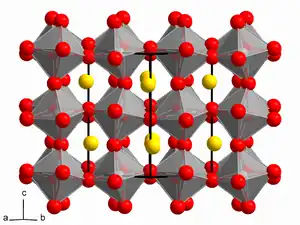Calcium titanate
Calcium titanate is an inorganic compound with the chemical formula Ca Ti O3. As a mineral, it is called perovskite, named after Russian mineralogist, L. A. Perovski (1792-1856). It is a colourless, diamagnetic solid, although the mineral is often coloured owing to impurities.
 | |
| Names | |
|---|---|
| Other names
calcium titanium oxide | |
| Identifiers | |
3D model (JSmol) |
|
| ChemSpider | |
| ECHA InfoCard | 100.031.795 |
PubChem CID |
|
| RTECS number |
|
| UNII | |
CompTox Dashboard (EPA) |
|
| |
| |
| Properties | |
| CaTiO3 | |
| Molar mass | 135.943 g/mol |
| Appearance | white powder |
| Density | 0.986 g/cm3 |
| Melting point | 1,975 °C (3,587 °F; 2,248 K) |
| Boiling point | 3,000 °C (5,430 °F; 3,270 K) |
| insoluble | |
| Hazards | |
| Lethal dose or concentration (LD, LC): | |
LD50 (median dose) |
>1200 mg/kg (oral, rat) |
| Thermochemistry | |
Std molar entropy (S⦵298) |
93.64 J/mol·K [1] |
Std enthalpy of formation (ΔfH⦵298) |
-1660.630 kJ/mol [1] |
Gibbs free energy (ΔfG⦵) |
-1575.256 kJ/mol [1] |
Except where otherwise noted, data are given for materials in their standard state (at 25 °C [77 °F], 100 kPa).
Infobox references | |
Synthesis
CaTiO3 can be prepared by the combination of CaO and TiO2 at temperatures >1300 °C. Sol-gel processes has been used to make a more pure substance, as well as lowering the synthesis temperature. These compounds synthesized are more compressible due to the powders from the sol-gel process as well and bring it closer to its calculated density (~4.04 g/ml).[2]
Structure
Calcium titanate is obtained as orthorhombic crystals, more specifically perovskite structure.[3] In this motif, the Ti(IV) centers are octahedral and the Ca2+ centers occupy a cage of 12 oxygen centres. Many useful materials adopt related structures, e.g. barium titanate or variations of the structure, e.g. yttrium barium copper oxide.
Applications
Calcium titanate has relatively little value except as one of the ores of titanium, together with several others. It is reduced to give titanium metal or ferrotitanium alloys.[4]
References
- Robie, R. A.; Hemmingway, B. S.; Fisher, J. R. (1978). "Thermodynamic properties of minerals and related substances at 298.15 K and 1 bar pressure and at higher temperature" (PDF). Geol. Surv. Bull.: 1452. Bibcode:1978BUSGS.....1452R. doi:10.3133/b1452.
- Dunn, Bruce; Zink, Jeffrey I. (September 2007). "Sol–Gel Chemistry and Materials". Accounts of Chemical Research. 40 (9): 729. doi:10.1021/ar700178b. PMID 17874844.
- Buttner, R. H.; Maslen, E. N. (1 October 1992). "Electron difference density and structural parameters in CaTiO3". Acta Crystallographica Section B. 48 (5): 644–649. doi:10.1107/S0108768192004592.
- Sibum, Heinz; Güther, Volker; Roidl, Oskar; Habashi, Fathi; Wolf, Hans Uwe (2000). "Titanium, Titanium Alloys, and Titanium Compounds". Ullmann's Encyclopedia of Industrial Chemistry. doi:10.1002/14356007.a27_095. ISBN 978-3-527-30673-2.